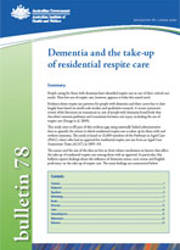Dementia and the take-up of residential respite care
Citation
AIHW
Australian Institute of Health and Welfare (2010) Dementia and the take-up of residential respite care, AIHW, Australian Government, accessed 04 May 2024.
APA
Australian Institute of Health and Welfare. (2010). Dementia and the take-up of residential respite care. Canberra: AIHW.
MLA
Australian Institute of Health and Welfare. Dementia and the take-up of residential respite care. AIHW, 2010.
Vancouver
Australian Institute of Health and Welfare. Dementia and the take-up of residential respite care. Canberra: AIHW; 2010.
Harvard
Australian Institute of Health and Welfare 2010, Dementia and the take-up of residential respite care, AIHW, Canberra.
PDF | 541Kb
In the current policy and service environment respite care is a key service designed to provide support for carers and those they care for. Linked aged care program data for the Pathways in Aged Care (PIAC) cohort study allows analysis of the take-up of residential respite care by looking at 32,000 cohort members who had an approval of such care. This bulletin presents take-up rates and factors that affect the take-up of residential respite care. In particular, the bulletin investigates whether dementia, carer availability and English speaking background affect the take-up of residential respite care.
- ISSN: 1446-9820
- ISBN: 978-1-74249-008-3
- Cat. no: AUS 124
- Pages: 24
-
A greater proportion of people with dementia took up respite (32%) than those without dementia (25%).
-
32,000 people in the PIAC cohort had been approved for respite residential aged care—around a quarter had dementia
-
34% of people with dementia who had a carer took up respite, compared with 24% for those without a carer



